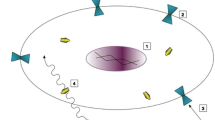Abstract
Firefly luciferase (FLuc)-based in vivo optical imaging technology exerts the non-invasive monitoring of transplanted cells in experimental animal models. This chapter introduces an established cell line that stably expresses a retrovirus-delivered FLuc protein gene. The stable expression does not affect the cell morphology, proliferation, migration, and invasion abilities of the parental cells. After implantation, the bioluminescence signal of FLuc cells truly reflects cell proliferation and survival in vivo, which can provide a reliable method for dynamic detection of in vivo cell transplantation.
Access this chapter
Tax calculation will be finalised at checkout
Purchases are for personal use only
Similar content being viewed by others
References
Progatzky F, Dallman MJ, Lo Celso C (2013) From seeing to believing: labelling strategies for in vivo cell-tracking experiments. Interface Focus 3:20130001. https://doi.org/10.1098/rsfs.2013.0001
Wu C, Xu B, Li X, Ma W, Zhang P, Chen X, Wu J (2017) Tracing and characterizing the development of transplanted female germline stem cells in vivo. Mol Ther 25:1408–1419. https://doi.org/10.1016/j.ymthe.2017.04.019
Farrelly O, Kuri P, Rompolas P (2019) In vivo genetic alteration and lineage tracing of single stem cells by live imaging. Methods Mol Biol 1879:1–14. https://doi.org/10.1007/7651_2018_172
Wang XJ, Li X, Ren Y (2016) Radionuclide imaging and treatment of thyroid cancer. Front Biosci (Landmark Ed) 21:1187–1193. https://doi.org/10.2741/4449
Ding N, Sano K, Kanazaki K, Shimizu Y, Watanabe H, Namita T, Shiina T, Ono M, Saji H (2020) Sensitive photoacoustic/magnetic resonance dual imaging probe for detection of malignant tumors. J Pharm Sci 109:3153–3159. https://doi.org/10.1016/j.xphs.2020.07.010
Pirovano G, Roberts S, Kossatz S, Reiner T (2020) Optical imaging modalities: principles and applications in preclinical research and clinical settings. J Nucl Med 61:1419–1427. https://doi.org/10.2967/jnumed.119.238279
Kircher MF, Gambhir SS, Grimm J (2011) Noninvasive cell‑tracking methods. Nat Rev Clin Oncol 8:677–688. https://doi.org/10.1038/nrclinonc.2011.141
Iafrate M, Fruhwirth GO (2020) How non-invasive in vivo cell tracking supports the development and translation of cancer immunotherapies. Front Physiol 11:154. https://doi.org/10.3389/fphys.2020.00154
Kim JE, Kalimuthu S, Ahn BC (2015) In vivo cell tracking with bioluminescence imaging. Nucl Med Mol Imaging 49:3–10. https://doi.org/10.1007/s13139-014-0309-x
Park JJ, Lee TS, Son JJ, Chun KS, Song IH, Park YS, Kim KI, Lee YJ, Kang JH (2012) Comparison of cell-labeling methods with 124I-FIAU and 64Cu-PTSM for cell tracking using chronic myelogenous leukemia cells expressing HSV1-tk and firefly luciferase. Cancer Biother Radiopharm 27:719–728. https://doi.org/10.1089/cbr.2012.1225
Han D, Wu JC (2020) Using bioengineered bioluminescence to track stem cell transplantation in vivo. Methods Mol Biol 2126:1–11. https://doi.org/10.1007/978-1-0716-0364-2_1
Li Y, Liu M, Cui J, Yang K, Zhao L, Gong M, Wang Y, He Y, He T, Bi Y (2018) Hepa1-6-FLuc cell line with the stable expression of firefly luciferase retains its primary properties with promising bioluminescence imaging ability. Oncol Lett 15:6203–6210. https://doi.org/10.3892/ol.2018.8132
Author information
Authors and Affiliations
Corresponding author
Editor information
Editors and Affiliations
Rights and permissions
Copyright information
© 2022 The Author(s), under exclusive license to Springer Science+Business Media, LLC, part of Springer Nature
About this protocol
Cite this protocol
Bi, Y., Zhang, N., He, Y. (2022). Non-invasive In Vivo Tracking of Mammalian Cells Stably Expressing Firefly Luciferase. In: Kim, SB. (eds) Bioluminescence. Methods in Molecular Biology, vol 2524. Humana, New York, NY. https://doi.org/10.1007/978-1-0716-2453-1_23
Download citation
DOI: https://doi.org/10.1007/978-1-0716-2453-1_23
Published:
Publisher Name: Humana, New York, NY
Print ISBN: 978-1-0716-2452-4
Online ISBN: 978-1-0716-2453-1
eBook Packages: Springer Protocols




